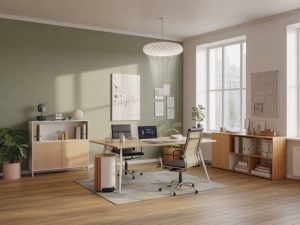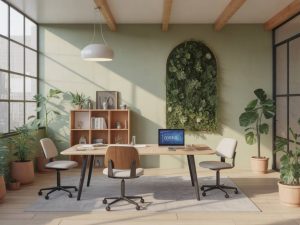Les technologies émergentes dans la purification de l’air pour les espaces de coworking en 2024

Les technologies émergentes dans la purification de l’air pour les espaces de coworking en 2024
Emerging Air Purification Technologies for Coworking Spaces in 2024
With more professionals returning to shared work environments, indoor air quality has become a top priority. Coworking spaces, in particular, must now balance health, energy efficiency, and user comfort. In 2024, emerging air purification technologies are transforming how shared workspaces approach clean air. These innovations go far beyond simple HEPA filters or basic ventilation, integrating AI, IoT, and advanced filtration methods to create healthier and more productive environments.
Why Clean Air Is Critical in Shared Workspaces
Coworking spaces host a steady flow of individuals from various backgrounds. This makes them particularly vulnerable to the transmission of airborne viruses, allergens, and volatile organic compounds (VOCs). High indoor pollutant concentrations can lead to:
- Increased coughing, sneezing, and spreading of germs
- Reduced cognitive functions due to elevated carbon dioxide (CO₂) levels
- Allergic reactions caused by dust, pollen, or mold
- Decreased productivity due to employee discomfort
Improving indoor air quality (IAQ) is therefore not only a health measure—it’s a business strategy. Companies that lease coworking spaces are now demanding smarter, tech-enhanced air quality solutions.
AI-Powered Air Quality Monitoring and Purification Systems
Artificial intelligence (AI) is playing a pivotal role in the next generation of air purification technologies for coworking spaces. These smart systems monitor and respond to indoor environmental data in real time. Key features include:
- Adaptive Purification: Air filtration automatically adjusts based on the concentration of airborne particles, VOCs, and humidity levels.
- Predictive Maintenance: AI models forecast when filters or UV-C bulbs need replacement, increasing system lifespan and efficiency.
- Remote Monitoring: Facility managers can optimize air quality across multiple coworking locations from a centralized dashboard.
Brands like Molekule and Dyson have introduced commercial-grade purifiers that integrate AI to track indoor air quality in real time. These devices are especially suited to coworking spaces where air conditions fluctuate throughout the day as occupancy changes.
Integration of IoT Sensors for Real-Time Air Data
The Internet of Things (IoT) is enabling an unprecedented level of transparency and control in air management. In modern coworking spaces, IoT sensors can collect data on:
- Humidity and temperature
- Airborne particulate matter (PM2.5 and PM10)
- CO₂ concentration
- VOC levels
- Presence and motion activity
These metrics are then used by building management systems (BMS) to control HVAC and purification systems. By making air quality data visible to occupants via mobile apps or wall-mounted displays, coworking operators build trust with clients concerned about their health and wellbeing.
UV-C Light for Germicidal Air Disinfection
UV-C technology—ultraviolet light in the C-band range (100–280 nm)—is being increasingly adopted in coworking spaces and office buildings to kill airborne pathogens. When integrated into HVAC systems or standalone air purifiers, UV-C light dismantles the DNA of microorganisms, neutralizing bacteria, viruses, and mold spores.
Recent innovations have tackled earlier design challenges such as:
- Minimizing ozone production (a harmful byproduct of some UV systems)
- Improving reflector materials for higher efficiency
- Automated shutdown mechanisms for user safety when servicing is required
UV-C LEDs, though currently more expensive than traditional mercury lamps, are becoming the preferred solution due to their longer lifespan and environmental safety.
HEPA Filters Evolve with Nanotechnology
High-Efficiency Particulate Air (HEPA) filters have long been a staple in air purification. But in 2024, nanotechnology is pushing the boundaries of filter performance. Nanofiber-enhanced filters offer several benefits over traditional materials:
- Trapping ultrafine particles down to 0.01 microns with increased efficiency
- Lower air resistance, resulting in quieter operation and reduced energy costs
- Antimicrobial coatings that neutralize bacteria and mold on contact
These advanced HEPA systems are ideal for urban coworking spaces where outdoor air pollution infiltrates more easily and demands on HVAC systems are high.
Biophilic and Eco-Friendly Air Purification Solutions
In parallel with high-tech solutions, natural air purification is making a comeback. Biophilic design integrates living elements—such as green walls and plant-based filters—to purify air while enhancing aesthetics and employee wellbeing. Coworking brands like Second Home in London already feature plant-saturated interiors designed for air detoxification.
Innovations in this field include:
- Active plant filtration systems using augmented root-zone biology
- Green wall panels embedded with living moss that absorb CO₂ and VOCs
- Biofiltration units that use water and micro-organisms to clean air mechanically
These solutions are not only decorative but functional, reducing stress and increasing satisfaction among coworkers.
Hybrid Solutions Combining Multiple Technologies
The most effective approach in 2024 combines multiple air purification technologies into hybrid systems. These solutions often integrate HEPA filters, activated carbon, UV-C, and IoT sensors within one device—offering a 360-degree response to indoor pollutants.
Multifunctional air purifiers are especially useful in coworking zones with varying layout types—open-plan areas, enclosed meeting rooms, phone booths, and kitchenettes. With smart zoning capabilities, hybrid systems can tailor their purification mode to the environment’s specific needs.
Some systems even learn usage patterns and adjust in anticipation of busy periods.
Installation and Maintenance Considerations for Shared Workspaces
Implementing new air purification technology should always consider operational feasibility. Coworking managers must assess:
- Ease of installation with existing HVAC systems
- Electrical requirements and noise levels
- Ongoing maintenance costs and access to replacement parts
- Compliance with local indoor air quality regulations
Manufacturers increasingly provide plug-and-play units that do not require ductwork modification. Others offer subscription models combining equipment, monitoring software, and service in an all-in-one package tailored for coworking operators.
The Future of Indoor Air Purification in Flexible Workspaces
As flexible working arrangements continue to evolve, coworking spaces are expected to maintain higher indoor air standards as a competitive advantage. Air purification will become part of the core infrastructure, much like Wi-Fi or lighting.
In 2024 and beyond, decision-makers in the coworking sector should focus on technologies that merge automation, data analytics, efficiency, and user wellness. Clean air is no longer a luxury—it’s a requirement for the health and productivity of tomorrow’s workforce.
For those considering the acquisition or upgrade of air purification systems, now is the ideal time to invest in advanced, scalable, and user-centric solutions that will stand the test of time in dynamic shared environments.





